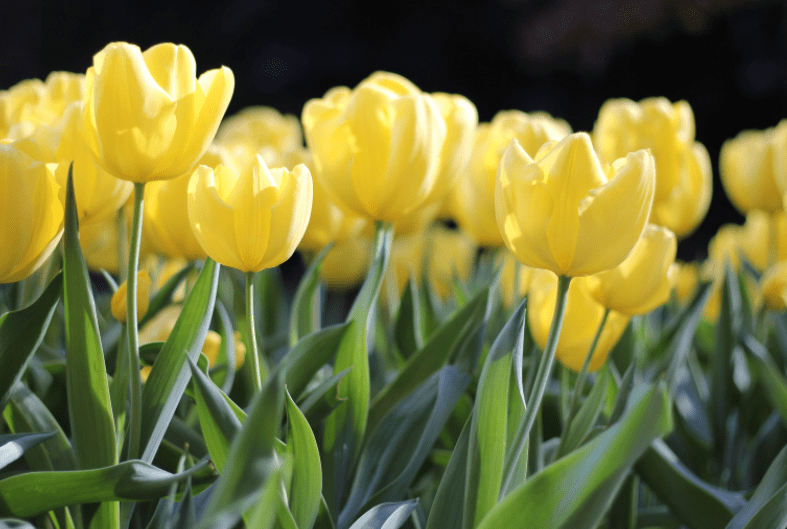Tulip Flower Tips
Even gardeners in mild climates can cultivate tulips successfully with Tulip flowers growing tips. We demonstrate how and share our favorite color schemes.
Anyone who has visited Holland knows that tulips thrive in cold winter climates. Nature bestows the land of windmills with months of winter chill that encourages robust growth in the bulbs.
Like brushstrokes on a canvas, swaths of silky-cupped beauties paint the landscape in the spring.
In climates with mild winters, however, growing tulips may be more difficult; without winter chill, many varieties bloom poorly, if at all.
Gardeners in mild-winter climates, such as San Diego and Phoenix, can cultivate them successfully every year with a bit of extra care and suitable varieties.
Gorgeous displays of tulips in public gardens from British Columbia to Southern California flaunt their irresistible jewel-tone colors each spring.
Creating a spectacular color display with tulips One reason for growing tulips is their magnificent coloration. The challenge is to produce harmonious combinations that bloom simultaneously.
Planting And Caring For Tulips
In the Western United States, tulip planting season begins in September in the coldest climates and in December in Southern California and the desert (to allow for the soil to cool).
As soon as possible, shop at nurseries or online for the best selection. Purchase only high-quality bulbs.
Queen of the Night’ ‘Maureen’ ‘Shirley’ ‘Dreaming Maid’ ‘Yellow Present’ ‘Beauty Queen’ ‘Maureen’ Queen of the Night’ ‘Maureen’ ‘Shirley’ ‘Dreaming Maid’ ‘Yellow Present
In mild climates, tulips should be chilled before planting. Keep the bulbs in paper or netted bags, not plastic, in the refrigerator’s vegetable drawer for six to eight weeks. Avoid mixing them with fruit.
In Soil
Plant in full sun and soil with good drainage. If the soil is dense, amend it with abundant organic material or plant in raised beds.
In the coldest climates (Sunset zones 1–6), mix a bulb fertilizer into the soil where bulbs will live for more than one season.
Plant at an appropriate depth. Follow the climate-specific instructions
Correctly segregate the items. Set apart tulip bulbs by two to four inches. When planting forget-me-nots, pansies, violas, or other flowers above the bulbs, space the tulips eight inches apart and the flowers ten inches apart in the center.
Water thoroughly after planting and frequently enough to prevent the soil from drying out in the absence of rain. When stems emerge from the soil, water to maintain a moist soil environment.
In mild climates, bulbs should be dug up and discarded after blooming. In cold temperatures, cut spent flowers for next year’s bloom.
Then apply nitrogen fertilizer and allow the leaves to produce nutrients. When the leaves turn yellow, they must be removed.
In A Container
Plant bulbs so that they are in contact.
Place the outermost bulbs so their flat sides are flush with the container’s rim (the first big leaf appears from the flat side of a bulb and will gracefully drape over the edge of the pot).
Cover with between 2 and 4 inches of soil. Monitor the soil to ensure that it does not become dry.
Place the container in partial shade until the first stems emerge, then transfer it to full sun. Once bulbs have sprouted, they should be watered regularly.
Tulip Flowers Growing Tips
To make the most of these blooms while they’re at this peak perfection, here are some tips for keeping cut tulips fresh, courtesy of the Netherlands Flower bulb Information Centre:
- Buy cut tulips when the buds are still closed but beginning to show the flower color.
- Play with color. Try something new each time. Create a wild riot of mixed colors, or try more subtle combos of similar shades, such as purple with lavender or pale yellow with deeper yellow.
- Unlike most cut flowers, tulips keep growing in a vase. They also tend to bend and move towards sources of light. Because tulips “dance in a vase,” they may need to be tidied up and turned in different directions now and then.
- Before arranging tulips, re-cut their stems. Use a sharp, clean knife cut on a slight angle. A fresh cut opens the stems’ water uptake channels.
- Don’t bother with flower food for tulips. Tulips drink a lot as they’re still growing, and plain water is all they want.
- Keep an eye on water levels and refresh vases with clean, cool water every two days.
- For the longest flower life, place tulips in a cool spot.


























